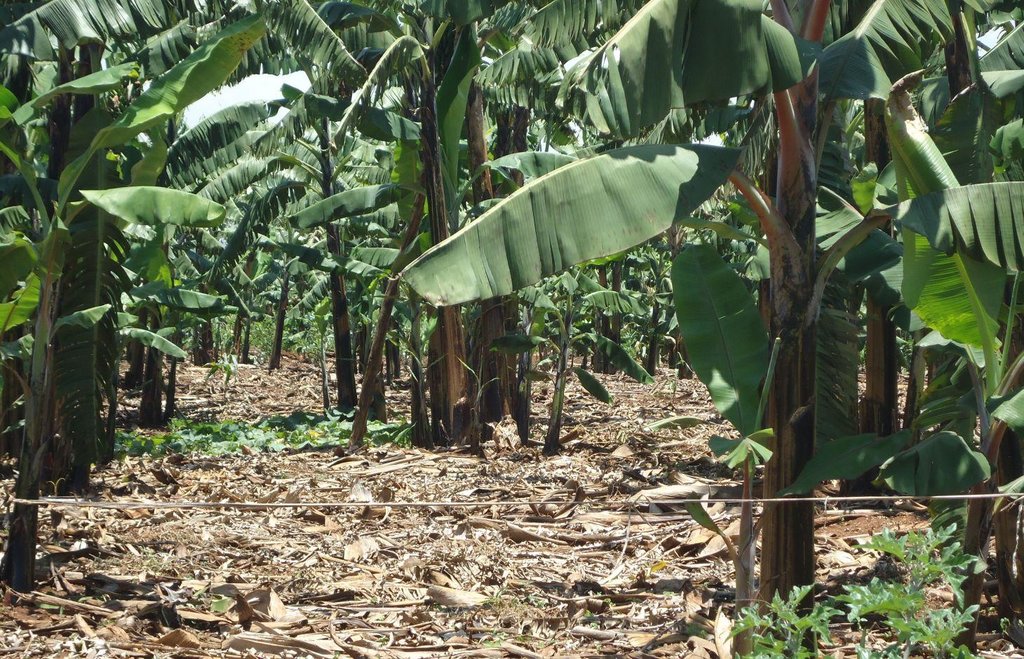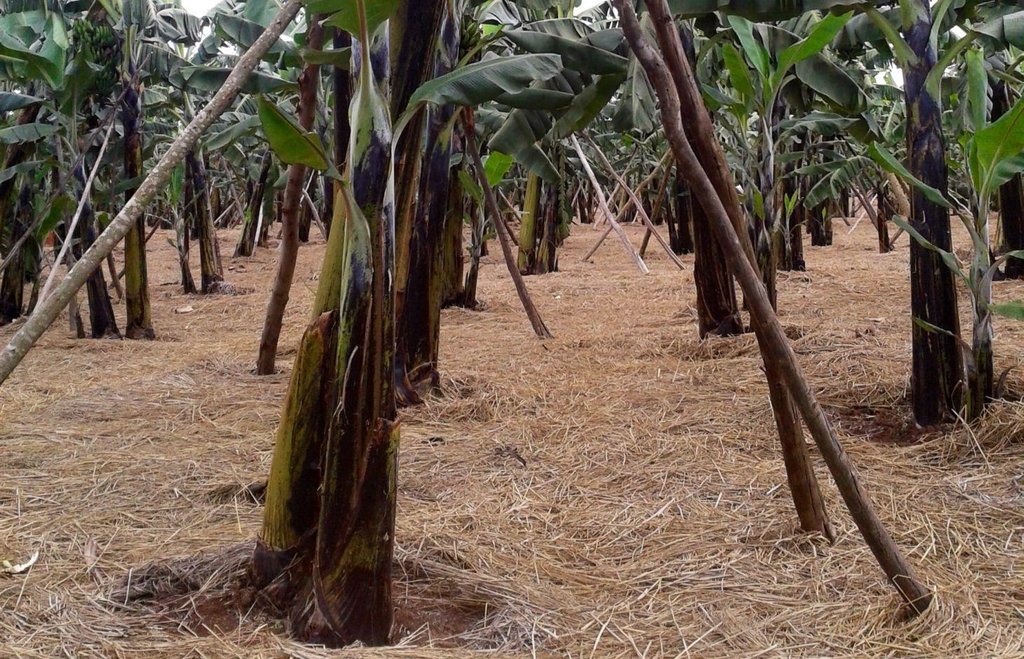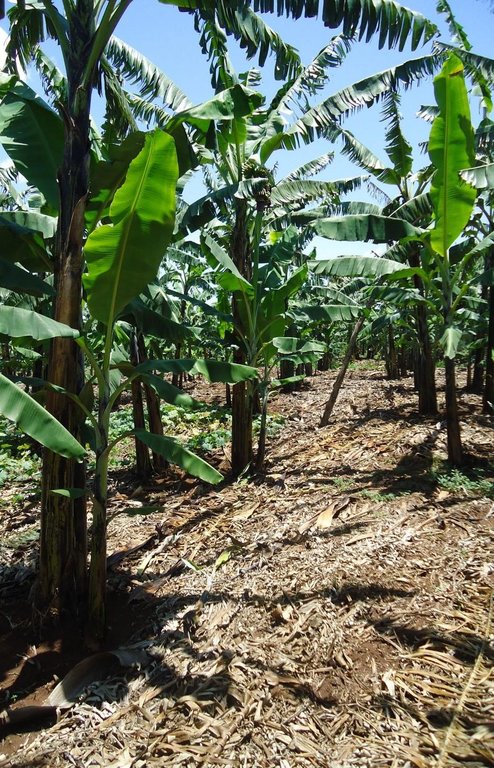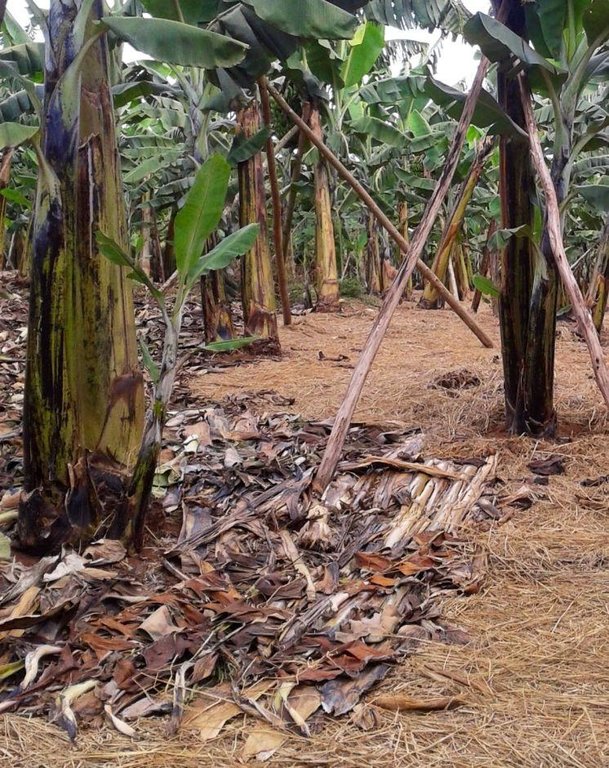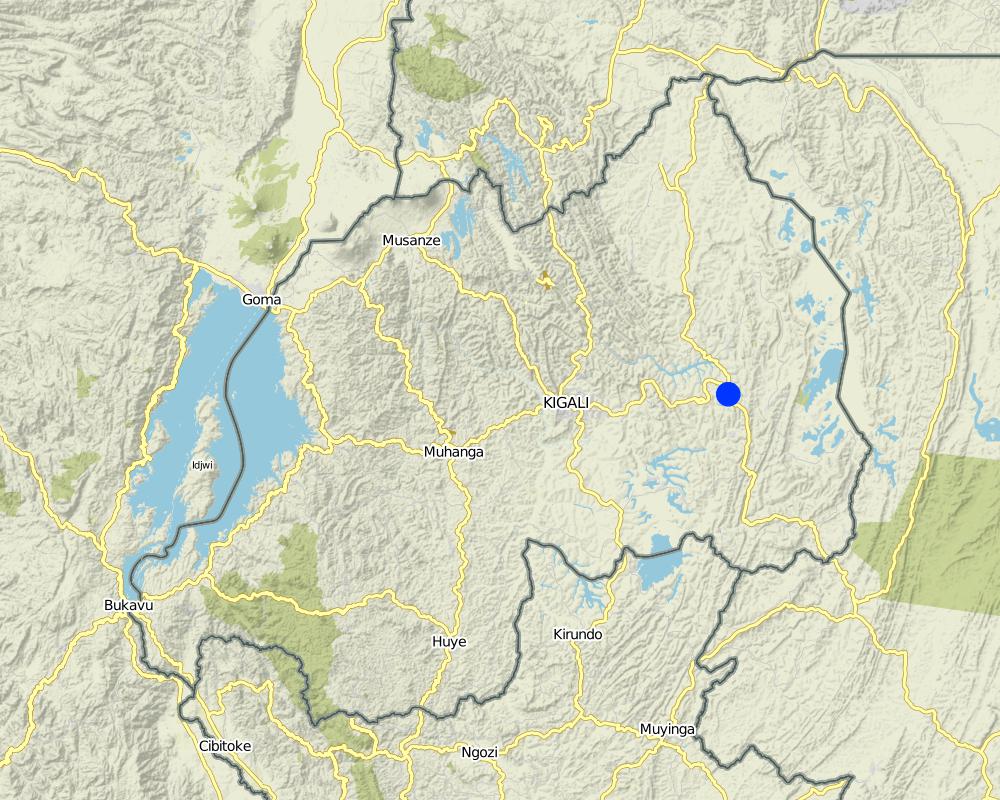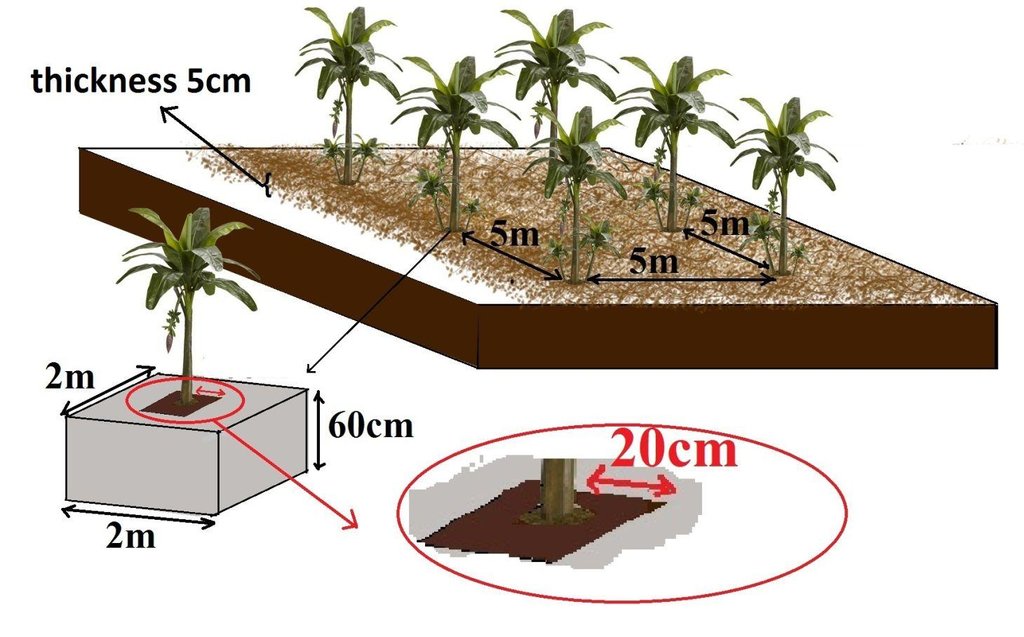Banana manure pits and mulching [卢旺达]
- 创建:
- 更新:
- 编制者: Desire Kagabo
- 编辑者: –
- 审查者: David Streiff, Alexandra Gavilano
Gusasira no gutera urutoki mu myobo irimo ifumbire mborera
technologies_1160 - 卢旺达
查看章节
全部展开 全部收起1. 一般信息
1.2 参与该技术评估和文件编制的资源人员和机构的联系方式
SLM专业人员:
SLM专业人员:
有助于对技术进行记录/评估的项目名称(如相关)
The Transboundary Agro-ecosystem Management Project for the Kagera River Basin (GEF-FAO / Kagera TAMP )有助于对技术进行记录/评估的机构名称(如相关)
Rwanda Agriculture Board (Rwanda Agriculture Board) - 卢旺达有助于对技术进行记录/评估的机构名称(如相关)
Food and Agriculture Organization of the United Nations (FAO) - 意大利1.3 关于使用通过WOCAT记录的数据的条件
编制者和关键资源人员接受有关使用通过WOCAT记录数据的条件。:
是
2. SLM技术的说明
2.1 技术简介
技术定义:
Banana planted in a regularly spaced manured pits and in combination with grass and banana mulch application to enhance soil fertility and moisture and improve crop production.
2.2 技术的详细说明
说明:
Banana is planted in a manure pit and the soil surface is carefully covered by banana or grass mulch. The manured pit is 0.6m deep and 2.0-2.0m wide. During establishment activities pits are filled with a mixture of soil and organic manure. Attention should be made when adding the mixed soil to the pits as a radius of 20 cm starting from the center of the pit where the banana is planted must not be filled with the mixture but filled merely with soil.This will assure that banana roots grow deeper in search for the nutrients. Recommended parallel and perpendicular spacing between the banana planting pits is 5m.
Purpose of the Technology: Banana manured pits and mulch application is a combination of an agronomic and structural technique. This method allows nutrients to be concentrated around the roots zone and keeps longer the available soil water content and controls the soil erosion.
Establishment / maintenance activities and inputs: The banana manure pits and mulching provides easy crop management options. The high demand of water and nutrients by banana can be easily met to maximize the fruiting potential. To achieve this potential, farmers are required to maintain a minimum of 3 plants per pit, one mature (grand) banana plant fruiting, a second half grown (mother), and one sucker (child) growing in the same pit. Every four months a farmer is expected to harvest a bunch of banana of around 80 kg per pit.
Natural / human environment: The constituted layer of mulch prevents rainwater from eroding the top soil, improves soil organic carbon, provides shade to plant roots, and most importantly keeps longer soil moisture in dry seasons.
2.3 技术照片
2.5 已应用该技术的、本评估所涵盖的国家/地区/地点
国家:
卢旺达
区域/州/省:
Rwanda
有关地点的进一步说明:
Kirehe District (Eastern province)
具体说明该技术的分布:
- 均匀地分布在一个区域
如果不知道精确的区域,请注明大致覆盖的区域:
- 10-100 平方千米
注释:
The area covered by this technology has been estimated
Map
×2.6 实施日期
如果不知道确切的年份,请说明大概的日期:
- 10-50年前
2.7 技术介绍
详细说明该技术是如何引入的:
- 通过土地使用者的创新
3. SLM技术的分类
3.1 该技术的主要目的
- 改良生产
3.2 应用该技术的当前土地利用类型

农田
- 多年一作(非木材)
多年生(非木质)作物 - 指定作物:
- 香蕉/芭蕉/蕉麻
每年的生长季节数:
- 2
具体说明:
Longest growing period in days: 180; Longest growing period from month to month: Sept to mid Febr; Second longest growing period in days: 150; Second longest growing period from month to month: mid March to mid Jun
注释:
Major cash crop and major food crop: Banana
Major land use problems (compiler’s opinion): Banana plantation is sensitive to dry season where evapotranspiration is high, and high erosion impact in rainy season.
Major land use problems (land users’ perception): Surface runoff
Future (final) land use (after implementation of SLM Technology): Cropland: Cp: Perennial (non-woody) cropping
3.3 由于技术的实施,土地使用是否发生了变化?
由于技术的实施,土地使用是否发生了变化?:
- 是(请在技术实施前填写以下有关土地利用的问题)

牧场
- Extensive grazing
3.4 供水
该技术所应用土地的供水:
- 雨养
3.5 该技术所属的SLM组
- 改良的地面/植被覆盖
- 土壤肥力综合管理
3.6 包含该技术的可持续土地管理措施

农艺措施
- A1:植被和土壤覆盖层

结构措施
- S4:平沟、坑
注释:
Main measures: agronomic measures, structural measures
Type of agronomic measures: mulching, manure / compost / residues, pits
3.7 该技术强调的主要土地退化类型

土壤水蚀
- Wt:表土流失/地表侵蚀

化学性土壤退化
- Cn:肥力下降和有机质含量下降(非侵蚀所致)
注释:
Main causes of degradation: soil management (Lack of knowledge in soil conservation practices.), droughts (it tend to happen due to the unpredictable rainfed changes), population pressure (as the population increases the soil exploitation increases as well)
Secondary causes of degradation: poverty / wealth
3.8 防止、减少或恢复土地退化
具体数量名该技术与土地退化有关的目标:
- 减少土地退化
注释:
Secondary goals: prevention of land degradation, rehabilitation / reclamation of denuded land
4. 技术规范、实施活动、投入和成本
4.1 该技术的技术图纸
技术规范(与技术图纸相关):
This technology consists of a pit of 0.6x2x2m respectively, for depth, length and width. Banana is planted in center of each pit in which organic manure from different sources is added and mixed with the soil. The spacing along the row and between rows is 5 m. The top soil is taken back and only 15-30 kg of organic manure are added and mixed with soil. Attention should be made when adding the mixed soil to the pits as a radius of 20 cm starting from the center of the pit where the banana is planted must not be filled with the mixture but filled merely with soil.
Location: Kayonza. Kayonza/South/Rwanda
Date: 2013
Technical knowledge required for field staff / advisors: moderate
Technical knowledge required for land users: low
Main technical functions: increase in organic matter, increase in nutrient availability (supply, recycling,…), increase of infiltration, increase / maintain water stored in soil, water harvesting / increase water supply
Secondary technical functions: control of raindrop splash, improvement of ground cover, improvement of topsoil structure (compaction), increase of groundwater level / recharge of groundwater, increase of biomass (quantity)
Mulching
Material/ species: grasses, crop residues and strow of banana
Quantity/ density: 50,000 m3
Remarks: in bananas field the thickness of mulch is about 5 cm, which including a total quantity of 50,000 m3
Manure / compost / residues
Material/ species: farmyard manure
Quantity/ density: 12t/ha
Remarks: According to the spacing only 400 banana can be grown per ha and a pits may receive 30 kg of FYM
Pits
Material/ species: A pit have a distance of 2m x 2m with 60cm deep
Quantity/ density: 400pitsha
Remarks: The distance between two pits is 1 m which means 5m between 2 consecutive banana
作者:
Kagabo Desire and Ngenzi Guy, RAB, 5016 Kigali
4.2 有关投入和成本计算的一般信息
具体说明成本计算所用货币:
- 美元
注明雇用劳工的每日平均工资成本:
1.70
4.3 技术建立活动
| 活动 | 时间(季度) | |
|---|---|---|
| 1. | Establishment of pits | |
| 2. | Seedling plantation | |
| 3. | Seedling transportation |
4.4 技术建立所需要的费用和投入
| 对投入进行具体说明 | 单位 | 数量 | 单位成本 | 每项投入的总成本 | 土地使用者承担的成本% | |
|---|---|---|---|---|---|---|
| 劳动力 | Land preparation, planting, thinning weeding | persons/day/ha | 221.7647 | 1.7 | 377.0 | 100.0 |
| 设备 | Tools | ha | 1.0 | 30.0 | 30.0 | 100.0 |
| 植物材料 | Acquisition of suckers | ha | 1.0 | 937.5 | 937.5 | 100.0 |
| 肥料和杀菌剂 | Compost manure | ha | 1.0 | 650.0 | 650.0 | 100.0 |
| 技术建立所需总成本 | 1994.5 | |||||
| 技术建立总成本,美元 | 1994.5 | |||||
注释:
Duration of establishment phase: 1 month(s)
4.5 维护/经常性活动
| 活动 | 时间/频率 | |
|---|---|---|
| 1. | Thinning banana field | dry season |
| 2. | Weeding | rainy season |
| 3. | Planting seedlings | rainy season |
4.6 维护/经常性活动所需要的费用和投入(每年)
| 对投入进行具体说明 | 单位 | 数量 | 单位成本 | 每项投入的总成本 | 土地使用者承担的成本% | |
|---|---|---|---|---|---|---|
| 劳动力 | Labour | ha | 1.0 | 42.0 | 42.0 | 100.0 |
| 劳动力 | Thinning and weeding | ha | 1.0 | 25.0 | 25.0 | 100.0 |
| 技术维护所需总成本 | 67.0 | |||||
| 技术维护总成本,美元 | 67.0 | |||||
4.7 影响成本的最重要因素
描述影响成本的最决定性因素:
The labor affects most the cost of this technology. However, suckers or planting materials could increase the cost if not readily available at farm gate or in the neighborhood.
5. 自然和人文环境
5.1 气候
年降雨量
- < 250毫米
- 251-500毫米
- 501-750毫米
- 751-1,000毫米
- 1,001-1,500毫米
- 1,501-2,000毫米
- 2,001-3,000毫米
- 3,001-4,000毫米
- > 4,000毫米
农业气候带
- 半湿润
Thermal climate class: tropics
5.2 地形
平均坡度:
- 水平(0-2%)
- 缓降(3-5%)
- 平缓(6-10%)
- 滚坡(11-15%)
- 崎岖(16-30%)
- 陡峭(31-60%)
- 非常陡峭(>60%)
地形:
- 高原/平原
- 山脊
- 山坡
- 山地斜坡
- 麓坡
- 谷底
垂直分布带:
- 0-100 m a.s.l.
- 101-500 m a.s.l.
- 501-1,000 m a.s.l.
- 1,001-1,500 m a.s.l.
- 1,501-2,000 m a.s.l.
- 2,001-2,500 m a.s.l.
- 2,501-3,000 m a.s.l.
- 3,001-4,000 m a.s.l.
- > 4,000 m a.s.l.
说明该技术是否专门应用于:
- 凹陷情况
5.3 土壤
平均土层深度:
- 非常浅(0-20厘米)
- 浅(21-50厘米)
- 中等深度(51-80厘米)
- 深(81-120厘米)
- 非常深(> 120厘米)
土壤质地(表土):
- 中粒(壤土、粉土)
表土有机质:
- 中(1-3%)
如有可能,附上完整的土壤描述或具体说明可用的信息,例如土壤类型、土壤酸碱度、阳离子交换能力、氮、盐度等。:
Soil fertility is medium
Soil drainage / infiltration is medium
Soil water storage capacity is medium - low
5.4 水资源可用性和质量
地下水位表:
5-50米
地表水的可用性:
匮乏/没有
水质(未处理):
不良饮用水(需要处理)
5.5 生物多样性
物种多样性:
- 中等
关于生物多样性的注释和进一步规范:
The mulched land become a suitable niche of many kind of lizard and rat
5.6 应用该技术的土地使用者的特征
生产系统的市场定位:
- 混合(生计/商业)
非农收入:
- 收入的10-50%
相对财富水平:
- 贫瘠
- 平均水平
个人或集体:
- 个人/家庭
机械化水平:
- 手工作业
说明土地使用者的其他有关特征:
Land users applying the Technology are mainly common / average land users
Population density: 200-500 persons/km2
Annual population growth: 2% - 3%
20% of the land users are average wealthy and own 70% of the land.
78% of the land users are poor and own 20% of the land.
2% of the land users are poor and own 5% of the land.
5.7 应用该技术的土地使用者使用的平均土地面积
- < 0.5 公顷
- 0.5-1 公顷
- 1-2 公顷
- 2-5公顷
- 5-15公顷
- 15-50公顷
- 50-100公顷
- 100-500公顷
- 500-1,000公顷
- 1,000-10,000公顷
- > 10,000公顷
这被认为是小规模、中规模还是大规模的(参照当地实际情况)?:
- 中等规模的
5.8 土地所有权、土地使用权和水使用权
土地所有权:
- 个人,有命名
土地使用权:
- 个人
用水权:
- 自由进入(无组织)
5.9 进入服务和基础设施的通道
健康:
- 贫瘠
- 适度的
- 好
教育:
- 贫瘠
- 适度的
- 好
技术援助:
- 贫瘠
- 适度的
- 好
就业(例如非农):
- 贫瘠
- 适度的
- 好
市场:
- 贫瘠
- 适度的
- 好
能源:
- 贫瘠
- 适度的
- 好
道路和交通:
- 贫瘠
- 适度的
- 好
饮用水和卫生设施:
- 贫瘠
- 适度的
- 好
金融服务:
- 贫瘠
- 适度的
- 好
6. 影响和结论性说明
6.1 该技术的现场影响
社会经济效应
生产
作物生产
SLM之前的数量:
50 tons
SLM之后的数量:
190 tons
注释/具体说明:
Because of the new technology the yield is 4 fold
生产故障风险
收入和成本
农业投入费用
农业收入
SLM之前的数量:
1233
SLM之后的数量:
4687
注释/具体说明:
The net family income has improved by 4 fold
社会文化影响
食品安全/自给自足
SLM之前的数量:
125
SLM之后的数量:
258
健康状况
SLM之前的数量:
70%
SLM之后的数量:
90%
livelihood and human well-being
注释/具体说明:
The technology increases banana production and the net farm income
生态影响
水循环/径流
地表径流
蒸发
土壤
土壤水分
土壤覆盖层
土壤流失
6.2 该技术的场外影响已经显现
地下水/河流污染
6.3 技术对渐变气候以及与气候相关的极端情况/灾害的暴露和敏感性(土地使用者认为的极端情况/灾害)
气候有关的极端情况(灾害)
气候灾害
| 该技术是如何应对的? | |
|---|---|
| 干旱 | 不好 |
6.4 成本效益分析
技术收益与技术建立成本相比如何(从土地使用者的角度看)?
短期回报:
轻度消极
长期回报:
非常积极
技术收益与技术维护成本/经常性成本相比如何(从土地使用者的角度看)?
短期回报:
稍微积极
长期回报:
非常积极
6.5 技术采用
- > 50%
如若可行,进行量化(住户数量和/或覆盖面积):
43000 housheolds covering 80 percent of stated area
在所有采用这项技术的人当中,有多少人是自发的,即未获得任何物质奖励/付款?:
- 91-100%
注释:
43000 land user families have adopted the Technology without any external material support
There is a strong trend towards spontaneous adoption of the Technology
6.7 该技术的优点/长处/机会
| 土地使用者眼中的长处/优势/机会 |
|---|
|
Increase production How can they be sustained / enhanced? Regular maintenance |
|
Reduce surface runoff by enhancing the retention soil moisture How can they be sustained / enhanced? Regular maintenance |
| 编制者或其他关键资源人员认为的长处/优势/机会 |
|---|
|
Increased food security and income of land users How can they be sustained / enhanced? Scaling up the technology |
|
Increased water holding capacity How can they be sustained / enhanced? Good maintenance by regularly replacing mulch |
|
Increased soil moisture How can they be sustained / enhanced? Good maintenance by adding very often organic manure |
6.8 技术的弱点/缺点/风险及其克服方法
| 编制者或其他关键资源人员认为的弱点/缺点/风险 | 如何克服它们? |
|---|---|
| This technology maybe expensive at establishment phase, maybe not affordable by every smallholder farmer | Allow farmers to access credits through farmer saving schemes or cooperatives |
7. 参考和链接
7.1 信息的方法/来源
链接和模块
全部展开 全部收起链接
无链接
模块
无模块




